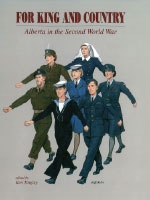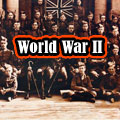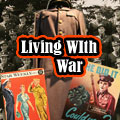Morale and Morality on the Alberta Homefront
Jeff Keshen
Reprinted with permission of the author and publisher of For King and Country: Alberta in the Second World War Indeed, whereas convictions for crimes of those under sixteen in Alberta stood at 58 per 1000 at the outset of the war, this climbed to 111 three years later; this rate was lower than Quebec [120] and Ontario [114], but above the national average of 101.46 Horror stories of wayward youth were cited by the Edmonton Family Welfare Bureau in one annual report which told of “a 12 year old boy approaching a group of soldiers with a contraceptive device ... and a 13 year old newsboy ... who was picked up at 12:20 a.m. in a cafe where he had been winning money from a drunken man by matching pennies”.47
Indeed, whereas convictions for crimes of those under sixteen in Alberta stood at 58 per 1000 at the outset of the war, this climbed to 111 three years later; this rate was lower than Quebec [120] and Ontario [114], but above the national average of 101.46 Horror stories of wayward youth were cited by the Edmonton Family Welfare Bureau in one annual report which told of “a 12 year old boy approaching a group of soldiers with a contraceptive device ... and a 13 year old newsboy ... who was picked up at 12:20 a.m. in a cafe where he had been winning money from a drunken man by matching pennies”.47
The fact that delinquency statistics peaked in 1942, the year Ottawa authorized the recruitment of mothers into war work, confirmed to many the fundamental cause; ignored, however, was the fact that over the next two years, before "Jill returned to the kitchen", national rates dropped by 5.5 and then 15.5 per cent. Although a mother's care in some households might have prevented some juvenile crime, especially in cases where the father was overseas, arrest patterns indicate other factors at work. During the war an increasing proportion of offences committed by youth were minor infractions such as breaking curfew. What this trend suggests is that even though police forces nationwide shrank from 1.30 officers per 1000 citizens in 1940 to 1.11 in 1944 the fact that they no longer had to concern themselves so much with 18-30 year old males, traditionally the most troublesome crime group, meant that in fact more effort could be devoted to prosecuting such petty offences.48 Arrests of juveniles for committing minor infractions began declining significantly in 1944, at a time when wounded veterans began returning home in increasing numbers and leave to Canada was introduced for those overseas; both these factors perhaps caused the reallocation of police resources to combat a rising number of major crimes within the population as a whole.49
Focusing upon the patriotic activities of countless children in wartime, a number of people dismissed the delinquency scare. Considering "all the confusion and tension [produced by the war]", said Fred Gardiner, the Superintendent of the Calgary Children's Aid Department, “youth has maintained a remarkably high standard of integrity”.50 In Edmonton high schools, for instance, students purchased $516.75 in War Savings Certificates in November 1940, a figure which climbed to $1,145 during the same month the following year. Girls also took Red Cross training while boys made model aircraft for RCAF recognition classes, or if between the ages of twelve and seventeen, joined the air, sea, or land cadets, whose ranks in Edmonton by January 1943 had grown to around 750.51 Praise was also accorded to thousands of adolescents for giving up part of their summer vacation to help bring in harvests, an activity encouraged by several Alberta school boards during the final three years of the war by changing the dates of this holiday to August through mid-October.52
No doubt, as one Edmonton teacher concluded, there was much "panic" in the reaction to wartime delinquency; still, this does not mean that no reason existed for concern over the lack of guidance and structure in many children's lives during these years.53 Particularly in places like Alberta, the war brought an upheaval from tranquil rural settings to the bustling streets, overcrowded homes, and larger schools of the urban sphere, a disruption which two-income families, sometimes coupled with absent parents, only served to exacerbate. Even when parents were home it was noted that some had no time for their children, such as night shift workers who, in order to get some sleep, often forced youngsters outside during the day to play. Organizations such as the Big Brothers argued that some children turned to gangs as a replacement for their disrupted families; their presence increased not only in Montreal and Toronto but also in Edmonton and Calgary.54 Lack of parental supervision was sometimes cited as the chief reason why girls were increasingly found on streets late at night; in Edmonton the number arrested for breaking the 10 p.m. curfew doubled during the first two years of the war, though the total figure still remained under fifty.55
Prosecutions under curfew regulations and compulsory education laws increased further as more young people worked full-time and in late-night jobs. In Alberta, as in schools across Canada, the war years witnessed a significant rise in non-attendance - 50 per cent in Edmonton between 1941 and 1944.56 After having watched their parents endure the Great Depression, numerous teenagers seized upon the new opportunities in the war economy to make money. Many left classes with the approval of their parents as schools received a record number of requests for permits to allow children to work full-time before reaching the age of sixteen; this was true particularly in cases where the father was overseas and the mother said she could not survive on a dependent's allowance. More widespread, according to school officials, were those parents just too busy to realize that their children, if not missing class to work long hours, were falling behind in their studies due to fatigue. To control such trends, Alberta schools appointed more attendance officers to track down truants, and with the help of the police warned a number of employers in sectors thought to be hiring minors [such as bowling alleys, pool halls and cafes] about the possibility of suffering hefty fines.57
Coupled with threats, curfews, and the condemnation of parental neglect was the conclusion reached by a growing number that the tendency of youth to choose menial jobs over school meant that the education system needed major modifications, particularly if Canada hoped to thrive in a presumably more complex postwar world. What the war did was help highlight some basic problems, many of which unsurprisingly were related to funding. At the outset of hostilities, public education in Alberta, as elsewhere in Canada, was overwhelmingly financed through local property taxes.
Notes
46. NAC, MG30 E256, Charlotte Whitton papers, Vol. 31, File “Juv-Del 1943”, A Statement on Juvenile Delinquency Prepared by a Committee of the Toronto Assistant Masters' Association, 1943.
47. PAA, Accession Number 83.192/754, Records of the Department of Public Welfare, Memo of the Edmonton Family Welfare Bureau, July 1943.
48. Canada Year Book, 1946, 1116.
49. Ibid, 1947, 260.
50. CC, Records of the Board of Commissioners, Series 3, Box 2, File 15, Report of the Children's Aid Department, 12 April 1945.
51. Edmonton Public School Board Archives [EPSB], Board Minutes, 2 Dec. 1941, 26 Jan. 1943.
52. A.T.A Magazine, May 1944, 30.
53. Ibid, March 1944, 8.
54. Ibid, Nov. 1945, 54-5.
55. Edmonton Police Archives, Annual Reports, 1939, 1940, 1941.
56. EPSB, Annual Report, 1946, 35.
57. NAC, RG 27, Records of the Department of labour, Vol. 988, File 1-1-4, undated memorandum.








